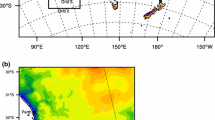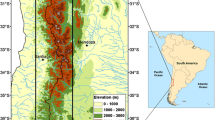Abstract
A modified Thornthwaite Climate Classification is applied to a 32-member ensemble of CMIP5 GCMs in order to 1) evaluate model performance in the historical climate and 2) assess projected climate change at the end of the 21stcentury following two greenhouse gas representative concentration pathways (RCP4.5 and RCP8.5). This classification scheme differs from the well-known Köppen approach as it uses potential evapotranspiration for thermal conditions, a moisture index for moisture conditions, and has even intervals between climate classes. The multi-model ensemble (MME) reproduces the main spatial features of the global climate reasonably well, however, in many regions the climate types are too moist. Extreme climate types, such as those found in polar and desert regions, as well as the cool- and cold-wet types of eastern North America and the warm and cool-moist types found in the southern U.S., eastern South America, central Africa and Europe are reproduced best by the MME. In contrast, the cold-dry and cold-semiarid climate types characterizing much of the high northern latitudes and the warm-wet type found in parts of Indonesia and southeast Asia are poorly represented by the MME. Regionally, most models exhibit the same sign in moisture and thermal biases, varying only in magnitude. Substantial changes in climate types are projected in both the RCP4.5 and RCP8.5 scenarios. Area coverage of torrid climate types expands by 11 % and 19 % in the RCP4.5 and RCP8.5 projections, respectively. Furthermore, a large portion of these areas in the tropics will experience thermal conditions which exceed the range of historical values and fall into a novel super torrid climate class. The greatest growth in moisture types in climate zones is among those with dry climates (moisture index values < 0) with increased areas of more than 8 % projected by the RCP8.5 MME.




Similar content being viewed by others
References
de Castro M, Gallardo C, Jylha K, Tuomenvirta H (2007) The use of a climate-type classification for assessing climate change effects in Europe from an ensemble of nine regional climate models. Clim Chang 81:329–341
Chen I, Hill J, Ohlemüller R, Roy D, Thomas C (2011) Rapid range shifts of species associated with high levels of climate warming. Science 33:1024–1026
Cohen J (1960) A coefficient of agreement for nominal scales. Educ Psychol Meas 20:37–46
Diaz HF, Eischeid JK (2007) Disappearing “alpine tundra” Köppen climatic type in the western United States. Geophys Res Lett 34
Feddema JJ (2005) A Revised Thorthwaite-type global climate classification. Phys Geogr 26(6):442–466
Federer C, Vörösmarty C, Fekete B (1996) Intercomparison of methods for calculating potential evaporation in regional and global water balance models. Water Resour Res 32(7):2315–2321
Frezzotti M, Urbini S, Proposito M, Scarchilli C, Gandolfi S (2007) Spatial and temporal variability of surface mass balance near Talos Dome, East Antarctica. J Geophys Res 112. doi:10.1029/2006JF000638
Gallardo C, Gil V, Hagel E, Tejeda C, de Castro M (2013) Assessment of climate change in Europe from an ensemble of regional climate models by the use of Köppen-Trewartha classification. Int J Climatol 33:2157–2166
Johnson C (1998) Rarity in the tropics: latitudinal gradients in distribution and abundance in Australian mammals. J Anim Ecol 67(5):689–698
Jylhä K, Tuomenvirta H, Ruosteenoja K, Niemi-Hugaerts H, Keisu K, Karhu J (2010) Observed and projected future shifts of climatic zones in Europe, and their use to visualize climate change information. Weather Clim Soc 2. doi:10.1175/2010WCAS1010.1
Kalvová J, Halenka T, Bezpalcová K, Nemesová I (2003) Köppen climate types in observed and simulated climates. Stud Geophys Geod 47:185–202
Köppen W (1900) Attempted climate classification in relation to plant distributions. Geogr Z 6:657–679
Landis J, Koch G (1977) The measurement of observer agreement for categorical data. Biometrics 33:159–74
Legates D, McCabe G (2005) A re-evaluation of the average annual global water balance. Phys Geogr 26(6):467–479
Legates D, Willmott C (1990) Mean seasonal and spatial variability in gauge-corrected, global precipitation. Int J Climatol 10:111–127
Lohmann U, Sausen R, Bengtsson L, Cubasch U, Perwitz J, Roeckner E (1993) The Köppen climate classification as a diagnostic tool for general circulation models. Clim Res 3:177–193
Mahlstein I, Daniel J, Solomon S (2013) Pace of shifts in climate regions increases with global temperature. Nat Clim Chang p. doi:10.1038/NCLIMATE1876
Manabe S, Holloway JL (1975) The seasonal variation of the hydrologic cycle as simulated by a global model of the atmosphere. J Geophys Res 80(12):1617–1649
McAfee S (2013) Methodological differences in projected potential evapotranspiration. Clim Chang doi:10.1007/s10584-013-0864-7
Monserud R, Leesman R (1992) Comparing global vegetation maps with the Kappa statistic. Ecol Model 62:275–293
Rahimi J, Ebrahimpour M, Khalili A (2013) Spatial changes of extended De Martonne climatic zones affected by climate change in Iran. Theor Appl Climatol 12. doi:10.1007/2Fs00704-012-0741-8
Rubel F, Kottek M (2010) Observed and projected climate shifts 1901–2100 depicted by world maps of the Köppen-Geiger climate classification. Meteorol Z 19(2):135–141
Scheff J, Frierson D (2012a) Robust future precipitation declines in CMIP5 largely reflect the poleward expansion of model subtropical dry zones. Geophys Res Lett 39:L18704. doi:10.1029/2012GL052910
Scheff J, Frierson D (2012b) Twenty-first century multimodel subtropical precipitation declines are mostly midlatitude shifts. J Clim in press. doi:10.1175/JCLI-D-11-00393.1
Stevens G (1989) The latitudinal gradients in geographical range: how so many species co-exist in the tropics. Am Nat 133:240–256
Strijbos J, Martens R, Prins F, Jochems W (2006) Content analysis: what are they talking about? Comput Educ 46. doi:10.1016/j.compedu.2005.04.002
Taylor K, Stouffer R, Meehl G (2012) An overview of CMIP5 and the experiment design. Bull Am Meteorol Soc. doi:10.1175/BAMS-D-11-00094.1
Thornthwaite C (1948) An approach towards a rational classification of climate. Geogr Rev 38(1). doi:10.1098/rspa.1948.0037
Thornthwaite C, Mather J (1955) The water balance. Publ Climatol 8:1–104
Vörösmarty C, Federer C, Schloss A (1998) Potential evaporation functions compared on US watersheds: possible implications for global-scale water balance and terrestrial ecosystem modeling. J Hydrol 207:147–169
Williams JW, Jackson ST, Kutzbach JE (2007) Projected distributions of novel and disappearing climates by 2100. AD PNAS 104(14):5738–5742
Willmott C, Feddema J (1992) A more rational climatic moisture index. Prof Geogr 44(1):84–88
Willmott C, Matsuura K (1995) Smart interpolation of annually averaged air temperature in the United States. J Appl Meteorol 34:2577–2586
Yin J (2005) A consistent poleward shift of the storm tracks in simulations of 21st century climate. Geophys Res Lett 32. doi:10.1029/2005GL023684
Acknowledgments
We acknowledge the World Climate Research Programme’s Working Group on Coupled Modelling, which is responsible for CMIP, and we thank the climate modeling groups (listed in Supplemental Table of this paper) for producing and making available their model output. For CMIP the U.S. Department of Energy’s Program for Climate Model Diagnosis and Intercomparison provides coordinating support and led development of software infrastructure in partnership with the Global Organization for Earth System Science Portals.
Author information
Authors and Affiliations
Corresponding author
Electronic supplementary material
Rights and permissions
About this article
Cite this article
Elguindi, N., Grundstein, A., Bernardes, S. et al. Assessment of CMIP5 global model simulations and climate change projections for the 21st century using a modified Thornthwaite climate classification. Climatic Change 122, 523–538 (2014). https://doi.org/10.1007/s10584-013-1020-0
Received:
Accepted:
Published:
Issue Date:
DOI: https://doi.org/10.1007/s10584-013-1020-0




